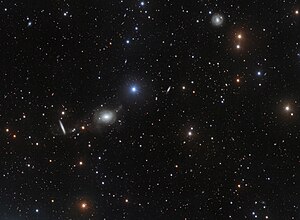NGC 5018
| Galaxy NGC 5018 |
|
|---|---|

|
|
| NGC 5018 (center left) | |
| AladinLite | |
| Constellation | Virgin |
|
Position equinox : J2000.0 , epoch : J2000.0 |
|
| Right ascension | 13 h 13 m 01.0 s |
| declination | -19 ° 31 ′ 05 ″ |
| Appearance | |
| Morphological type | E3: |
| Brightness (visual) | 10.7 mag |
| Brightness (B-band) | 11.7 mag |
| Angular expansion | 3.4 ′ × 2.6 ′ |
| Position angle | 112 ° |
| Surface brightness | 13.1 mag / arcmin² |
| Physical data | |
| Affiliation | LGG 337 |
| Redshift | 0.009393 ± 0.000003 |
| Radial velocity | 2816 ± 1 km / s |
|
Stroke distance v rad / H 0 |
(120 ± 8) x 10 6 ly (36.9 ± 2.6) Mpc |
| history | |
| discovery | Wilhelm Herschel |
| Discovery date | April 8, 1788 |
| Catalog names | |
| NGC 5018 • UGCA 335 • PGC 45908 • ESO 576-10 • MCG -03-34-017 • IRAS 13103-1915 • 2MASX J13130099-1931058 • SGC 131020-1915.3 • GC 3448 • H II 746 • h 1554 • LDCE 0955 NED013 | |
NGC 5018 is a 10.7 likes bright elliptical galaxy from the Hubble type E3 in the constellation Virgo to the ecliptic . It is estimated to be 120 million light years away from the Milky Way and has a diameter of around 130,000 ly. Together with NGC 5022, it forms a gravitationally bound pair of galaxies.
The galaxy NGC 5006 is located in the same area of the sky .
The object was discovered on April 8, 1788 by Wilhelm Herschel with an 18.7-inch reflector telescope, who described it as "pB, S, pBN".
Web links
Commons : NGC 5018 - collection of images, videos, and audio files
- NGC 5018. SIMBAD, accessed February 24, 2015 .
- NGC 5018. DSO Browser, accessed February 24, 2015 .
- ESO: Elliptical Elegance (with photos, map, animation) August 8, 2018
